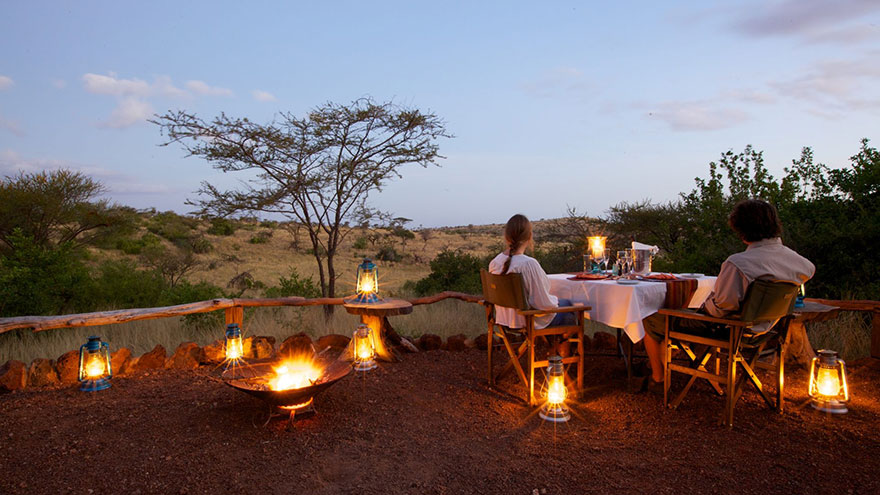Safari and Adventure Camping in Kenya
Kenya has some of nature’s most remarkable national parks and wildlife viewing in the world. Lions, leopards, hyenas, hippos and a multitude of other animals roam its many habitats.
With numerous well-maintained campsites around the country, you can get closer to nature than ever before.

Maasai Mara National Park
Famous for its striking savanna, late summer wildebeest migrations and high density lion population, the Maasai Mara, located in Western Kenya, has innumerable safari and private and public camping options. In private camps, safari tents set up by lodge owners include breakfast, dinner and nicer amenities.
Public camps are located near most entrance gates, including the Oloololo Camp and Sand River Campsite. You can expect showers and toilets but little else. You’ll have to bring your own gear and food. The public camps are not fenced so don’t be surprised if animals wander onto your campsite at night. For comfort and safety, hire a ranger to stay with your party overnight.
If you’re using your own car — and for public camping renting a 4-by-4 is highly recommended — you can start your own private safari at the crack of dawn with the ranger you hired the night before. If you don’t have transportation, its better to stay in a private campsite that provides safaris packages. It’s important to note that the Kenya Wildlife Service, or KWS, does not operate within the Maasai Mara, so ensure that you hire a local guide at the check-in gates.
Lake Nakuru National Park
Known as the flamingo park, this protected area in Central Kenya, is home to one of Africa’s most elusive species: the white rhino. One of the few places in East Africa where you can spot these magnificent creatures, Lake Nakuru also has more than 400 species of birds and large herds of buffalo. Public camps are set up at Makalia and Backpackers sites, although Makalia is often quieter.
Private camp sites include Naishi, Rhino and Nyati. Guards at night are less common at Lake Nakuru, as it’s considered less dangerous than the Mara. However, you can always request one to stay with you at KWS headquarters inside the park.
Tsavo East and West National Parks
When combined, the land mass of Tsavo east and west make for one of the largest national parks in the world. Located in southeastern Kenya, between Nairobi and Mombasa, this is an excellent spot for camping as it has some of the darkest skies in the world, making the stars a spectacular evening display.
Public campsites include Ndololo, but the best way to find a good spot is to ask the KWS rangers at the gate. The rangers guide you to areas based on recent herd migrations and environmental factors like flooding. Safaris take visitors past the verdant Galana River to glimpse the 500 species of bird, and more than 50 species of mammals including lions, leopards, hyenas, elephants and rhino.
Amboseli National Park
The herds of free range elephants here are one of the biggest draws to the park. Located in southern Kenya, near the Tanzania border, Mt. Kilimanjaro looms over the park giving safaris here a formidable backdrop. In addition, the low scrub means that the chances of seeing a cheetah or lion are fairly good.
At Amboseli’s public campsite, you’ll find tents and cooking gear ready to rent, or you can take your own equipment and choose your own space. Some areas of the campsite have fencing, although KWS rangers are stationed nearby regardless.
A Bit About Safety
Although camping in the habitat of such incredible predators might seem counter-intuitive, it’s fairly safe as long as certain precautions are taken. First, understand that you probably will have lions, hyenas and various other nocturnal creatures in or around your campsite. However, they’re somewhat used to humans and find them unappetizing.
Avoid acting like prey — don’t run screaming, just back up slowly — and this works in the vast majority of wildlife interactions. Starting a fire on the campsite also keeps animals at bay as all wildlife has an innate fear of flames. Understand that most creatures view a tent the same way they view a rock; they don’t see it as something to “get into.” Keep all food items out of the tent, and remember to close the flap entirely.
Although it’s a lovely feeling to gaze out into Africa’s starry skies, hyenas are notoriously curious, and if they see a way into a tent, they’ll come exploring. However, with the added benefit of guards at most campsites, this is a rare concern.
You Might Also Like :: The Top Five Must See Wild Animals When on a Safari

